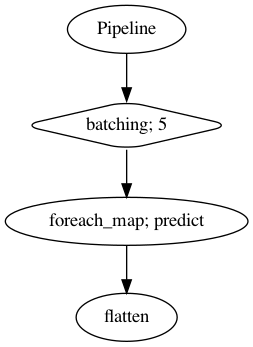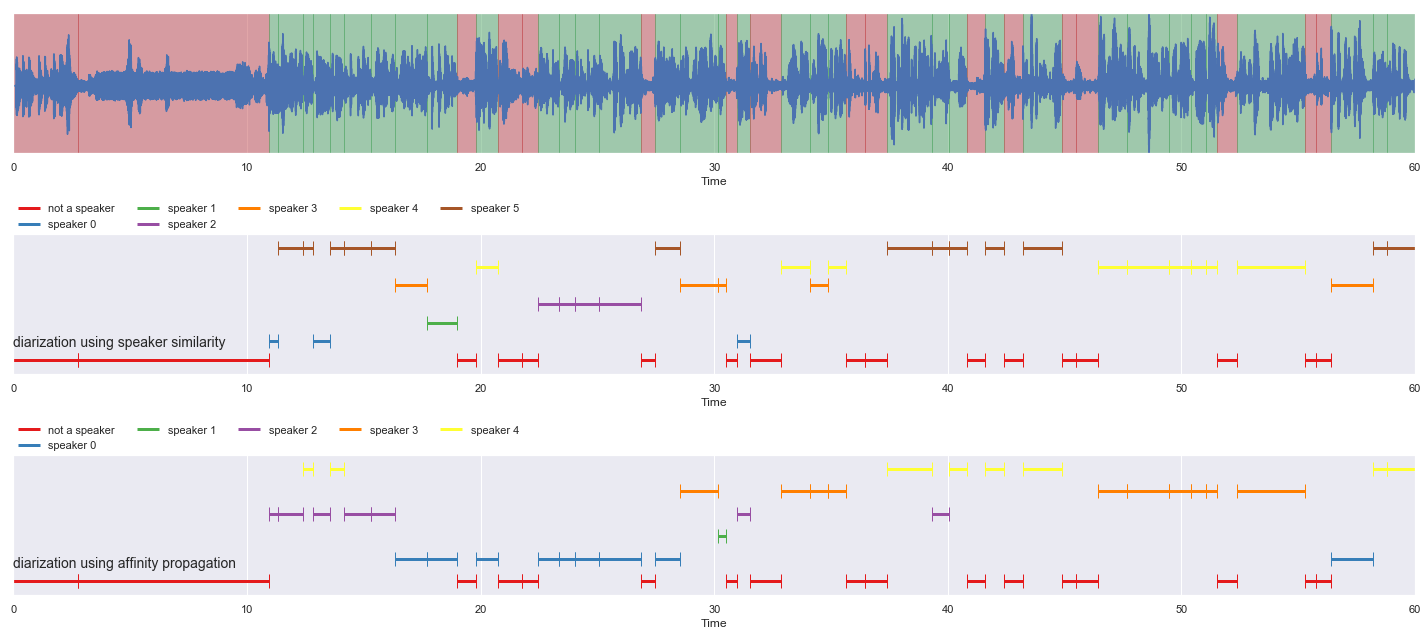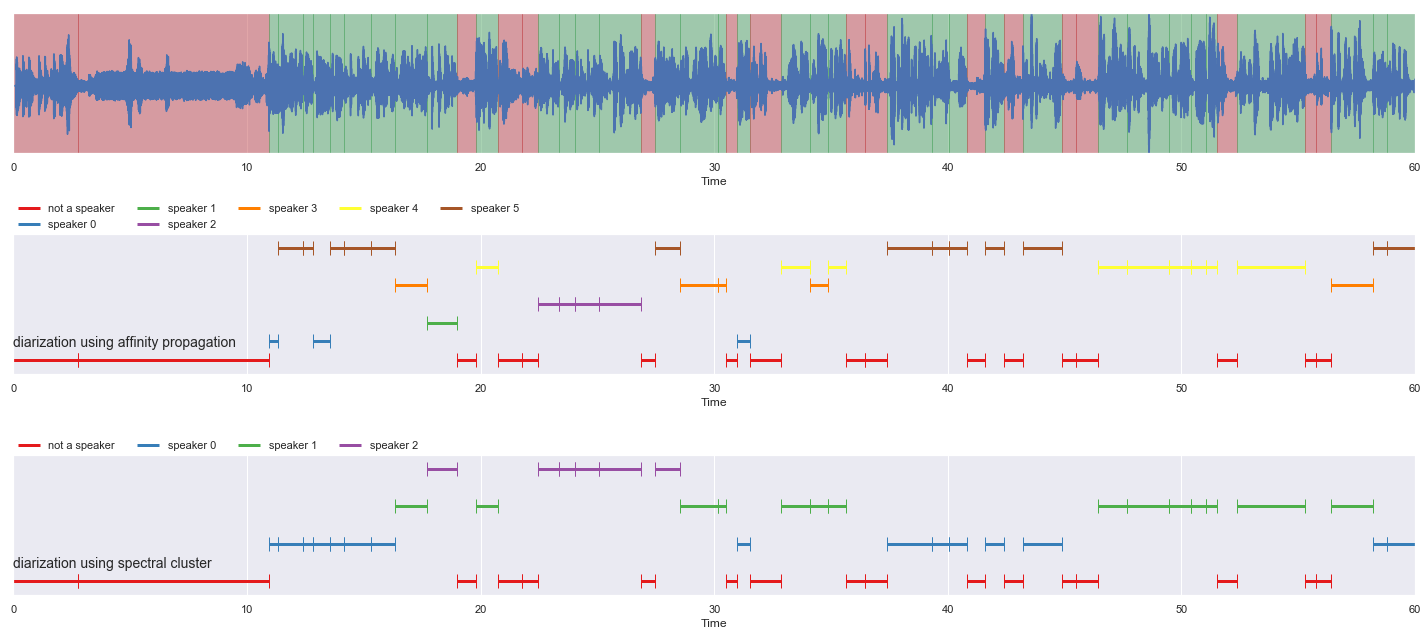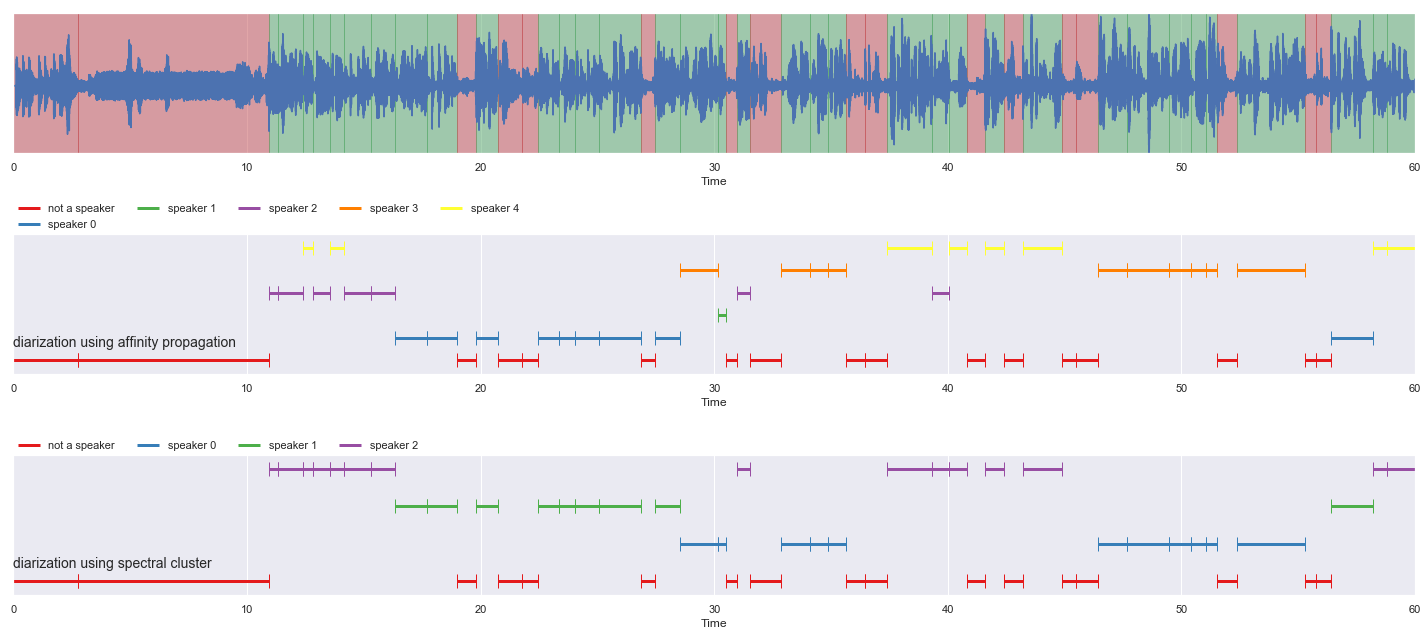Unsupervised clustering
Contents
Unsupervised clustering#
This tutorial is available as an IPython notebook at malaya-speech/example/diarization-clustering.
This module is language independent, so it save to use on different languages. Pretrained models trained on multilanguages.
This is an application of malaya-speech Pipeline, read more about malaya-speech Pipeline at malaya-speech/example/pipeline.
What is Speaker Diarization#
In one audio sample, we want to know the timestamp for multiple speakers.
[1]:
from malaya_speech import Pipeline
import malaya_speech
import numpy as np
import matplotlib.pyplot as plt
load Speaker Vector#
So to know speakers similarity, we can use speaker vector, just load using malaya_speech.speaker_vector.deep_model. Read more about malaya-speech Speaker Vector at https://malaya-speech.readthedocs.io/en/latest/load-speaker-vector.html
We are going to compare conformer-base and vggvox-v2.
[2]:
model_conformer = malaya_speech.speaker_vector.deep_model('conformer-base')
model_vggvox2 = malaya_speech.speaker_vector.deep_model('vggvox-v2')
Load audio sample#
[3]:
y, sr = malaya_speech.load('speech/video/The-Singaporean-White-Boy.wav')
len(y), sr
[3]:
(1634237, 16000)
[4]:
# just going to take 60 seconds
y = y[:sr * 60]
This audio extracted from https://www.youtube.com/watch?v=HylaY5e1awo&t=2s
Load VAD#
We need to use VAD module to know which parts of the audio sample are speaker activities, read more about VAD at https://malaya-speech.readthedocs.io/en/latest/load-vad.html
[5]:
vad = malaya_speech.vad.deep_model(model = 'vggvox-v2')
[6]:
frames = list(malaya_speech.utils.generator.frames(y, 30, sr))
[7]:
p = Pipeline()
pipeline = (
p.batching(5)
.foreach_map(vad.predict)
.flatten()
)
p.visualize()
[7]:

[8]:
%%time
result = p(frames)
result.keys()
/Library/Frameworks/Python.framework/Versions/3.7/lib/python3.7/site-packages/librosa/core/spectrum.py:224: UserWarning: n_fft=512 is too small for input signal of length=480
n_fft, y.shape[-1]
CPU times: user 1min 2s, sys: 38.4 s, total: 1min 40s
Wall time: 21 s
[8]:
dict_keys(['batching', 'predict', 'flatten'])
[9]:
frames_vad = [(frame, result['flatten'][no]) for no, frame in enumerate(frames)]
grouped_vad = malaya_speech.utils.group.group_frames(frames_vad)
grouped_vad = malaya_speech.utils.group.group_frames_threshold(grouped_vad, threshold_to_stop = 0.3)
[10]:
malaya_speech.extra.visualization.visualize_vad(y, grouped_vad, sr, figsize = (15, 3))

Use any clustering model#
def clustering(
vad_results,
speaker_vector,
model,
norm_function: Callable = l2_normalize,
log_distance_metric: str = None,
return_embedding: bool = False,
):
"""
Speaker diarization using any clustering model.
Parameters
----------
vad_results: List[Tuple[Frame, label]]
results from VAD.
speaker_vector: callable
speaker vector object.
model: callable
Any unsupervised clustering model.
Required `fit_predict` or `apply` or `predict` method.
norm_function: Callable, optional(default=malaya_speech.utils.dist.l2_normalize)
normalize function for speaker vectors.
log_distance_metric: str, optional (default=None)
post distance norm in log scale metrics.
this parameter is necessary for model that required square array input.
Common value is one of ['cosine', 'angular'].
Returns
-------
result : List[Tuple[Frame, label]]
"""
So you can use something like sklearn.cluster.AffinityPropagation or https://github.com/wq2012/SpectralCluster
Affinity Propagation#
We can use sklearn.cluster.AffinityPropagation.
[11]:
from sklearn.cluster import AffinityPropagation
ap = AffinityPropagation(
damping=0.8,
max_iter=100,
convergence_iter=15,
preference=None,
affinity='precomputed',
)
[14]:
result_diarization_ap_conformer = malaya_speech.diarization.clustering(
vad_results = grouped_vad,
speaker_vector = model_conformer,
model = ap,
log_distance_metric = 'cosine',
)
result_diarization_ap_conformer[:5]
/Library/Frameworks/Python.framework/Versions/3.7/lib/python3.7/site-packages/sklearn/cluster/_affinity_propagation.py:152: FutureWarning: 'random_state' has been introduced in 0.23. It will be set to None starting from 0.25 which means that results will differ at every function call. Set 'random_state' to None to silence this warning, or to 0 to keep the behavior of versions <0.23.
FutureWarning)
[14]:
[(<malaya_speech.model.frame.Frame at 0x17bebd2d0>, 'not a speaker'),
(<malaya_speech.model.frame.Frame at 0x17bea4ad0>, 'not a speaker'),
(<malaya_speech.model.frame.Frame at 0x17be99990>, 'speaker 0'),
(<malaya_speech.model.frame.Frame at 0x17be99910>, 'speaker 5'),
(<malaya_speech.model.frame.Frame at 0x17be99bd0>, 'speaker 5')]
[15]:
result_diarization_ap_vggvox2 = malaya_speech.diarization.clustering(
vad_results = grouped_vad,
speaker_vector = model_vggvox2,
model = ap,
log_distance_metric = 'cosine',
)
result_diarization_ap_vggvox2[:5]
/Library/Frameworks/Python.framework/Versions/3.7/lib/python3.7/site-packages/sklearn/cluster/_affinity_propagation.py:152: FutureWarning: 'random_state' has been introduced in 0.23. It will be set to None starting from 0.25 which means that results will differ at every function call. Set 'random_state' to None to silence this warning, or to 0 to keep the behavior of versions <0.23.
FutureWarning)
[15]:
[(<malaya_speech.model.frame.Frame at 0x17bebd2d0>, 'not a speaker'),
(<malaya_speech.model.frame.Frame at 0x17bea4ad0>, 'not a speaker'),
(<malaya_speech.model.frame.Frame at 0x17be99990>, 'speaker 2'),
(<malaya_speech.model.frame.Frame at 0x17be99910>, 'speaker 2'),
(<malaya_speech.model.frame.Frame at 0x17be99bd0>, 'speaker 4')]
[18]:
nrows = 3
fig, ax = plt.subplots(nrows = nrows, ncols = 1)
fig.set_figwidth(20)
fig.set_figheight(nrows * 3)
malaya_speech.extra.visualization.visualize_vad(y, grouped_vad, sr, ax = ax[0])
malaya_speech.extra.visualization.plot_classification(result_diarization_ap_conformer,
'diarization using speaker similarity', ax = ax[1],
x_text = 0.01)
malaya_speech.extra.visualization.plot_classification(result_diarization_ap_vggvox2,
'diarization using affinity propagation', ax = ax[2],
x_text = 0.01)
fig.tight_layout()
plt.show()

Spectral Clustering#
This is a Python re-implementation of the spectral clustering algorithm in the paper Speaker Diarization with LSTM.
So, make sure you already install spectralcluster,
pip install spectralcluster
[24]:
from spectralcluster import SpectralClusterer
clusterer = SpectralClusterer(
min_clusters=3,
max_clusters=100,
)
[25]:
result_diarization_sc_conformer = malaya_speech.diarization.clustering(
vad_results = grouped_vad,
speaker_vector = model_conformer,
model = clusterer,
)
result_diarization_sc_conformer[:5]
[25]:
[(<malaya_speech.model.frame.Frame at 0x17bebd2d0>, 'not a speaker'),
(<malaya_speech.model.frame.Frame at 0x17bea4ad0>, 'not a speaker'),
(<malaya_speech.model.frame.Frame at 0x17be99990>, 'speaker 0'),
(<malaya_speech.model.frame.Frame at 0x17be99910>, 'speaker 0'),
(<malaya_speech.model.frame.Frame at 0x17be99bd0>, 'speaker 0')]
[26]:
result_diarization_sc_vggvox2 = malaya_speech.diarization.clustering(
vad_results = grouped_vad,
speaker_vector = model_vggvox2,
model = clusterer,
)
result_diarization_sc_vggvox2[:5]
[26]:
[(<malaya_speech.model.frame.Frame at 0x17bebd2d0>, 'not a speaker'),
(<malaya_speech.model.frame.Frame at 0x17bea4ad0>, 'not a speaker'),
(<malaya_speech.model.frame.Frame at 0x17be99990>, 'speaker 2'),
(<malaya_speech.model.frame.Frame at 0x17be99910>, 'speaker 2'),
(<malaya_speech.model.frame.Frame at 0x17be99bd0>, 'speaker 2')]
[27]:
nrows = 3
fig, ax = plt.subplots(nrows = nrows, ncols = 1)
fig.set_figwidth(20)
fig.set_figheight(nrows * 3)
malaya_speech.extra.visualization.visualize_vad(y, grouped_vad, sr, ax = ax[0])
malaya_speech.extra.visualization.plot_classification(result_diarization_ap_conformer,
'diarization using affinity propagation', ax = ax[1],
x_text = 0.01)
malaya_speech.extra.visualization.plot_classification(result_diarization_sc_conformer,
'diarization using spectral cluster', ax = ax[2],
x_text = 0.01)
fig.tight_layout()
plt.show()

[28]:
nrows = 3
fig, ax = plt.subplots(nrows = nrows, ncols = 1)
fig.set_figwidth(20)
fig.set_figheight(nrows * 3)
malaya_speech.extra.visualization.visualize_vad(y, grouped_vad, sr, ax = ax[0])
malaya_speech.extra.visualization.plot_classification(result_diarization_ap_vggvox2,
'diarization using affinity propagation', ax = ax[1],
x_text = 0.01)
malaya_speech.extra.visualization.plot_classification(result_diarization_sc_vggvox2,
'diarization using spectral cluster', ax = ax[2],
x_text = 0.01)
fig.tight_layout()
plt.show()

